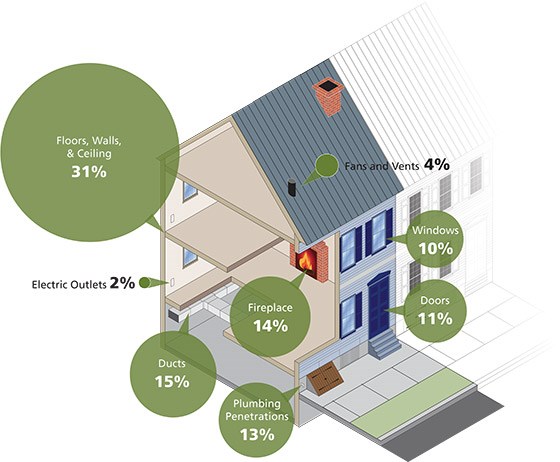Last updated: April 11, 2022
Article
Weatherization of Historic Buildings: Eliminate Air Infiltration

Source: U. S. Department of Energy
Air infiltration is the exchange of air through cracks and gaps in the outside shell of a building. Infiltration increases heating and cooling costs and reduces the comfort level of occupants. Loose fitting windows and doors, cracks between the house and the foundation, and gaps around plumbing and electrical penetrations are typical sources of leaks.
Reducing air infiltration is often the first action item of a weatherization plan after the energy audit has been completed. Caulking cracks, sealing an unused fireplace, and adding weatherstripping are simple, low-cost improvements that can reduce air infiltration. Caulking should be done with care to ensure that the function of a building element is not impaired. For example, caulking may be added to close a gap between window frames and the outside wall if needed, but not between window sash and the jamb which would prevent the window from opening. Instead, weatherstripping can be added to exclude air and allow the sash to operate. Typical places to check for air infiltration include:
- Electrical outlets, switches, and ceiling fixtures
- Operable features of windows and doors – check for a loose fit
- Window and door frames where they meet the wall
- Baseboards
- Fireplace dampers
- Chimney flashing and flues
- Attic hatches
- Wall or window-mounted air conditioners
- Plumbing, electrical, cable, and telephone penetrations
- Ducts in unconditioned spaces (though conductive heat loss is generally more significant in this situation, see Install insulation)
Although reducing air infiltration is recommended, it is not advisable to seal a historic building too tightly. This could result in a lack of adequate ventilation or, in extreme cases, sick building syndrome. All air movement may not be eliminated after infiltration in these areas has been addressed. However, air movement is not necessarily a sign of energy inefficiency, but can be a factor in occupant comfort. It can cause occupants to feel uncomfortable and to assume that energy is being lost. In warmer climates, air movement can make occupants feel cooler, and in cooler climates it can make occupants feel chilly. If uncomfortable drafts continue after air infiltration has been addressed, consider other options for making your historic spaces more comfortable such as hanging drapery or rearranging furniture placement to avoid the air movement.
